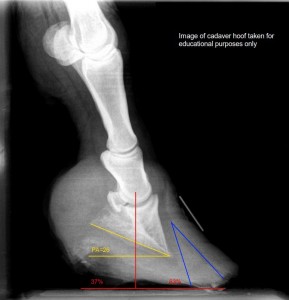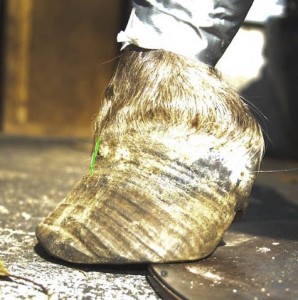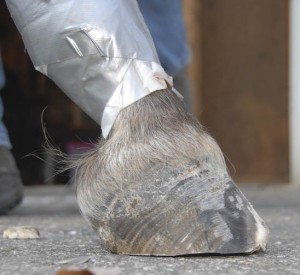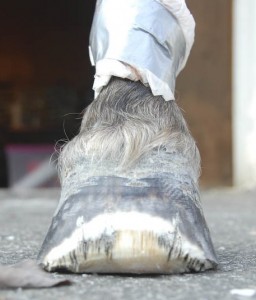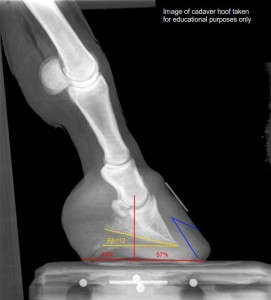Last month I spent some time down in Pennsylvania at Daisy Haven Farm doing come continuing education learning the value of having x-rays to more accurately trim a horse’s hoof. Part of the workshop was a day of looking at hoof distortion and how to correct for it. To aid in this, cadaver hooves are x-rayed before they are trimmed and then again after the trim. Later the group gets together to critique the effectiveness of the trim. Since I had done Daisy’s 5 day workshop on this in May, I knew the procedure, so I found the most foundered cadaver foot available to improve my eye for trimming for that type of distortion.
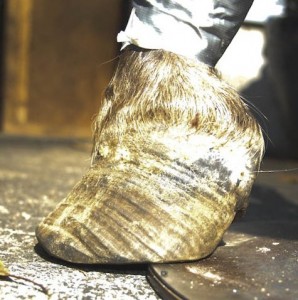 This foot had quite a severe dish and is quite long.
This foot had quite a severe dish and is quite long.
Looking at the x-ray, the coffin bone ( the triangular bone in the hoof capsule) has rotated quite a bit away from parallel to the hoof wall, which is where it normally should be located. The bottom part of the coffin bone should be at have a 3-8° angle with a line parallel with the ground. This is called the palmer angle (PA). In this x-ray, the palmer angle is 26 and is shown in yellow. The blue lines show the lamellar wedge, which is made up of stretched lamella (the material that attaches the hoof to the coffin bone) and poorly organized hoof material. This is the material that fills the gap that exists between where the hoof wall is and where it should be. The Center of Rotation (COR) is the point at the end of the second paster bone (P2) around which the coffin bone rotates. It has been found that in a healthy foot, half of the foot will be in front of a line dropped down from the COR and half will be behind it. The red lines show the balance of the hoof around the center of rotation . The COR is at the top of the vertical red line.
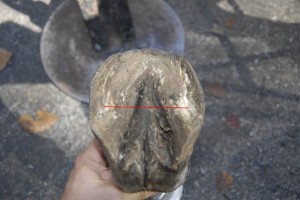 On the sole of the foot, a line projected down from the COR usually corresponds to landmarks on the sole, such as the widest part of the sole, the end of the bars and the bar swells (not clear on this photo). It is usually about an inch behind the apex of the frog. The red line on the photo of the sole of the foot has been placed using measurements from the x-ray, and is quite close to where it would be placed using the landmarks on the sole of the foot, showing the reliability of those landmarks.
On the sole of the foot, a line projected down from the COR usually corresponds to landmarks on the sole, such as the widest part of the sole, the end of the bars and the bar swells (not clear on this photo). It is usually about an inch behind the apex of the frog. The red line on the photo of the sole of the foot has been placed using measurements from the x-ray, and is quite close to where it would be placed using the landmarks on the sole of the foot, showing the reliability of those landmarks.
The toe of the foot before trimming shows a considerable dish. The top 1/2 to 3/4 inch of the hoof wall beneath the coronary band (shown by the green line) gives an indication of where the wall would be growing if the wall was well connected. This angle is used to guide the removal of material from the toe wall.
After the center of the foot was determined, the heels were shortened to bring the coffin bone back to a more normal angle and the lamellar wedge was reduced using a rasp and a belt sander. This brought the toe to an angle that approximates where it would be if the wall was still well connected. This will expose the lamellar wedge, but it is sufficiently hardened that it will provide sufficient protection for the sensitive lamina. The toe was then bevelled to bring the balance of the foot closer to the ideal 50/50 ratio, resulting in a foot that looks much closer to normal
After trimming another x-ray was taken and as you can see, the palmer angle has been reduced, and is much closer to the ideal 3-8°. The balance of the foot is much closer to the ideal. There is still some heel that could be removed and that would bring the foot closer to the ideal palmer angle, as well as improve the ratio around the COR.
This shows the importance of having quality x-rays of the foot, so that it is possible to get a better idea of the angles of the internal structures within the foot before attempting to improve the hoof. The external markers are very useful, but more rapid rehabilitation is possible through the use of x-rays.

